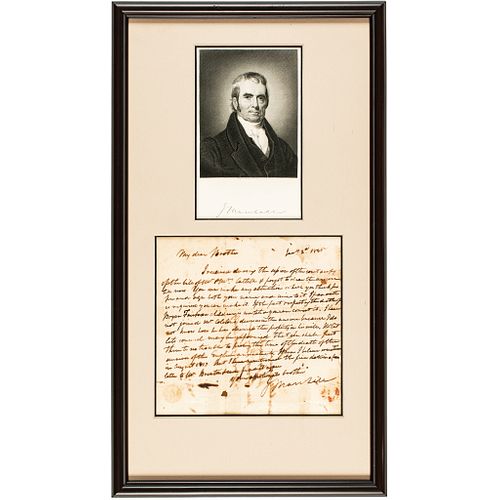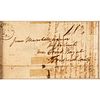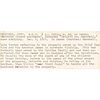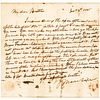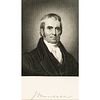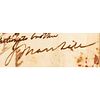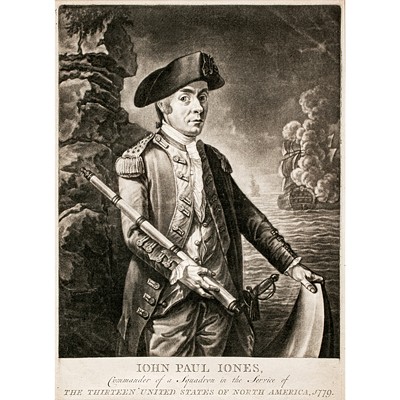JOHN MARSHALL ALS to His Brother James, While U.S. Supreme Court Chief Justice
Lot 33
Categories
Estimate:
$3,000 - $4,000
Absentee vs Live bid
Two ways to bid:
- Leave a max absentee bid and the platform will bid on your behalf up to your maximum bid during the live auction.
- Bid live during the auction and your bids will be submitted real-time to the auctioneer.
Bid Increments
| Price | Bid Increment |
|---|---|
| $0 | $10 |
| $200 | $20 |
| $300 | $25 |
| $500 | $50 |
| $1,000 | $100 |
| $2,000 | $200 |
| $3,000 | $250 |
| $5,000 | $500 |
| $10,000 | $1,000 |
| $20,000 | $2,000 |
| $30,000 | $2,500 |
| $50,000 | $5,000 |
| $100,000 | $10,000 |
| $200,000 | $20,000 |
| $300,000 | $25,000 |
| $500,000 | $50,000 |
About Auction
By Early American History Auctions
Jan 23, 2021
Set Reminder
2021-01-23 12:00:00
2021-01-23 12:00:00
America/New_York
Bidsquare
Bidsquare : Early American History Auction of Autographs, Americana, Political & Maps
https://www.bidsquare.com/auctions/early-american-history-auctions/early-american-history-auction-of-autographs-americana-political-maps-6311
311 Lots of Rare, Historic Autographs, Americana, Civil War Era, George Washington, Abraham Lincoln, Slavery & Black History, Revolutionary War Era, Colonial America, Federal Period, War of 1812, Colonial Currency, Indian Peace Medals & more... Early American History Auctions auctions@earlyamerican.com
311 Lots of Rare, Historic Autographs, Americana, Civil War Era, George Washington, Abraham Lincoln, Slavery & Black History, Revolutionary War Era, Colonial America, Federal Period, War of 1812, Colonial Currency, Indian Peace Medals & more... Early American History Auctions auctions@earlyamerican.com
- Lot Description
Autographs
John Marshall ALS to His Brother James While U.S. Supreme Court Chief Justice Dealing with Matters After the Death of Bryan Lord Fairfax
JOHN MARSHALL (1755-1835). Fourth Chief Justice of the U.S. Supreme Court.
January 2, 1828-Dated, Autograph Letter Signed, "J. Marshall", round Postmark of Richmond, VA. on the opposite side Integral Address Leaf, Fine. This boldly handwritten Letter measures 7-1/4" x 7-3/8" (by sight) and has been professionally mounted, together with a 7" x 4.25" steel engraving of Justice Marshall that shows his signature in facsimile in a display frame. The overall size of the frame measures 20" x 11". This Letter was directed to John Marshall's brother James, where he writes, in full:
"My dear Brother -- I received during the session of the court a copy of the will of Mr. & Mrs. Catlett & forgot to draw the answer till now. You can make any alteration which you think proper and sign your name and mine to it. If an oath is required you can make it. If the part respecting the death of Bryan Fairfax's children is misstated you can correct it. I have not joined Mr. Colstons division in the answer because I do not know how he has devised the property in his will. Mr. Catletts counsel may be informed that we shall put them to no trouble to prove the time of the death of the survivor of the English annuitants. It was I believe sometime in August 1817. But I have mentioned the prior date in a form letter to Mr. Brenton & I can find it again. Your affectionate brother, - (Signed) J. Marshall".
Rev. Bryan Fairfax, 8th Lord Fairfax of Cameron (1736-1802) was an Anglican clergyman and Scottish peer (the title was created in 1627 before the Union of 1707). He was a lifelong friend of George Washington and became the first American-born Lord Fairfax; his predecessors were born in the UK. He lived in Virginia. He was the grandson of Reverend the Hon. Henry Fairfax, second son of the fourth Lord. However, it wasn't until 1800 that he was confirmed in the title by the House of Lords.
This personal Letter was written late in Marshall's life, and refers to the property owned by his brother and himself in Northern Virginia. Because he was so tied up with his work as Chief Justice on the Supreme Court, he relied heavily on his brother James to handle the necessary and appropriate dealings.
Two custom openings in the back of the frame allow both sides to be viewed, and shows:
1. A vintage typewritten description (our consignor purchased this letter in 1979) and
2. The Address Leaf, written in John Marshall's hand.
This Letter is boldly written on period wove paper in rich brown ink and appears to be in good condition (not examined out of the frame) with some even toning with some show-through of ink from the address leaf. There is a small pencil eraser size paper loss just left of center in the lower portion of the letter in the blank field well below the written text. John Marshall's signature is strong, measuring a full 3" long with the envelope red wax seal seen below at right.
John Marshall's full Autographed Letters are valuable, and even his cut signature is quite rare as his popular signature always brings strong prices when available. A lovely display presentation.
John Marshall (September 24, 1755 - July 6, 1835) was an American politician and lawyer who served as the fourth Chief Justice of the United States from 1801 to 1835. Marshall remains the longest-serving chief justice and fourth-longest serving justice in Supreme Court history, and he is widely regarded as one of the most influential justices to ever sit on the Supreme Court. Prior to joining the Supreme Court (and for one month simultaneous to his tenure as Chief Justice), Marshall served as the United States Secretary of State under President John Adams.
Marshall was born in Germantown in the Colony of Virginia in 1755. After the outbreak of the American Revolutionary War, he joined the Continental Army, serving in numerous battles. During the later stages of the war, he was admitted to the state bar and won election to the Virginia House of Delegates. Marshall favored the ratification of the United States Constitution, and he played a major role in Virginia's ratification of that document. At the request of President Adams, Marshall traveled to France in 1797 to help bring an end to attacks on American shipping. In what became known as the XYZ Affair, the government of France refused to open negotiations unless the United States agreed to pay bribes. After returning to the United States, Marshall won election to the United States House of Representatives and emerged as a leader of the Federalist Party in Congress. He was appointed secretary of state in 1800 after a cabinet shake-up, becoming an important figure in the Adams administration.
In 1801, Adams appointed Marshall to the Supreme Court. Marshall quickly emerged as the key figure on the court, due in large part to his personal influence with the other justices. Under his leadership, the court moved away from seriatim opinions, instead issuing a single majority opinion that elucidated a clear rule. The 1803 case of Marbury v. Madison presented the first major case heard by the Marshall Court. In his opinion for the court, Marshall upheld the principle of judicial review, whereby courts could strike down federal and state laws if they conflicted with the Constitution. Marshall's holding avoided direct conflict with the executive branch, which was led by Democratic-Republican President Thomas Jefferson. By establishing the principle of judicial review while avoiding an inter-branch confrontation, Marshall helped implement the principle of separation of powers and cement the position of the American judiciary as an independent and co-equal branch of government.
After 1803, many of the major decisions issued by the Marshall Court confirmed the supremacy of the federal government and the federal Constitution over the states. In Fletcher v. Peck and Dartmouth College v. Woodward, the court invalidated state actions because they violated the Contract Clause. The court's decision in McCulloch v. Maryland upheld the constitutionality of the Second Bank of the United States and established the principle that the states could not tax federal institutions. The cases of Martin v. Hunter's Lessee and Cohens v. Virginia established that the Supreme Court could hear appeals from state courts in both civil and criminal matters. Marshall's opinion in Gibbons v. Ogden established that the Commerce Clause bars states from restricting navigation. In the case of Worcester v. Georgia, Marshall held that the Georgia criminal statute that prohibited non-Native Americans from being present on Native American lands without a license from the state was unconstitutional. Marshall died in 1835, and Jackson appointed Roger Taney as his successor.
Rev. Bryan Fairfax, 8th Lord Fairfax of Cameron (1736-1802) was an Anglican clergyman and Scottish peer (the title was created in 1627 before the Union of 1707). He was a lifelong friend of George Washington and became the first American-born Lord Fairfax; his predecessors were born in the UK. The Rev. The Lord Fairfax was the first cousin once removed of the seventh of the lived. He lived in Virginia. He was the grandson of Reverend the Hon. Henry Fairfax, second son of the fourth Lord. However, it wasn't until 1800 that he was confirmed in the title by the House of Lords.
- Shipping Info
-
Early American provides in-house worldwide shipping. Please contact us directly if you have questions about your specific shipping requirements.
-
- Buyer's Premium



 EUR
EUR CAD
CAD AUD
AUD GBP
GBP MXN
MXN HKD
HKD CNY
CNY MYR
MYR SEK
SEK SGD
SGD CHF
CHF THB
THB